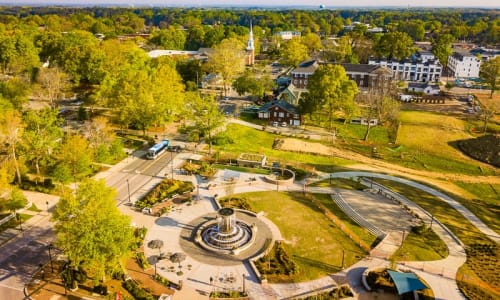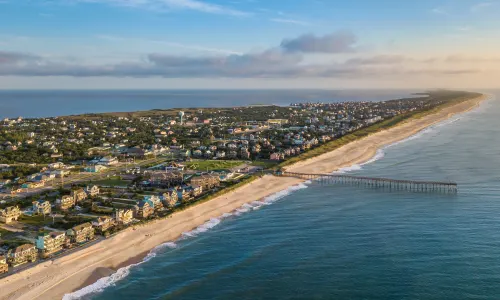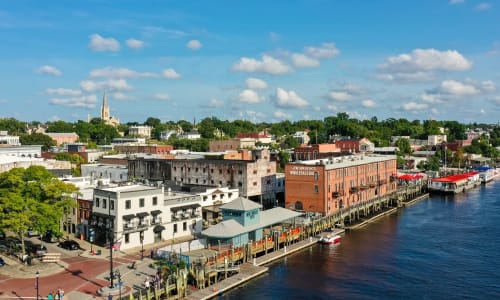LookyLOO Review of North Carolina
North Carolina is one of the fastest-growing states in the country, driven by a combination of economic opportunity, natural beauty, and a more reasonable cost of living than many large metro areas on the East Coast. For people looking to bail on expensive cities like New York, Boston, or D.C., North Carolina’s growing mid-sized cities hit a sweet spot—offering urban energy without the overwhelming cost or scale.
Charlotte and Raleigh remain the fastest-growing hubs, but what’s fueling the state’s appeal are cities like Durham, Winston-Salem, Greensboro, and Asheville. These places have seen significant investment in arts, culture, and local businesses, creating vibrant downtowns and neighborhoods while maintaining accessibility and affordability. Wilmington, with its historic riverfront and proximity to beaches, adds a coastal option with similar momentum.
North Carolina offers a blend of lifestyles—from dense city cores to suburban communities and small mountain or coastal towns—all within a state that delivers four distinct seasons and easy access to both the Atlantic and the Appalachians.
Lifestyle
Living in North Carolina means having access to almost every kind of landscape and lifestyle you can imagine. The mountains of western North Carolina, including the Blue Ridge and Smokies, draw hikers, climbers, and people looking for small-town life with incredible scenery. Asheville anchors the region with a nationally recognized food scene, music venues, craft breweries, and a progressive arts community—all surrounded by nature.
Along the coast, places like Wilmington, New Bern, and the Outer Banks offer a completely different pace of life—historic charm, beach towns, and maritime culture.
In between, North Carolina’s mid-sized cities have grown into dynamic cultural hubs. Durham, once defined by tobacco warehouses, is now a food, music, and startup center, balancing grit and growth. Greensboro and Winston-Salem have embraced their history while building arts districts, indie music venues, and foodie scenes that attract newcomers looking for quality of life without the price tag of bigger cities.
Outdoor recreation is baked into the lifestyle—weekends are often spent hiking, kayaking, hitting the coast, or exploring dozens of state parks. Meanwhile, urban centers keep adding restaurants, music festivals, museums, and farmers markets that make daily life feel rich and varied.
Housing costs have risen, particularly in Charlotte, Raleigh, and Asheville, but remain notably more reasonable compared to cities like D.C., New York, or Boston. Mid-sized cities and suburbs still offer affordable homeownership options, which continues to draw families, young professionals, and retirees.
Who’s Moving to North Carolina?
Young professionals and remote workers: The combination of job opportunities and lifestyle has put places like Raleigh, Durham, and Charlotte on the map. Increasingly, mid-sized cities like Winston-Salem, Greensboro, and Asheville are drawing remote workers who want cultural amenities without the high price tag.
Families: Good schools, growing suburbs, and attainable home prices make North Carolina a top choice for families leaving higher-cost states. Suburban areas around Raleigh and Charlotte, like Cary or Huntersville, are growing fast.
Retirees: North Carolina is a retirement destination—particularly western towns like Asheville, Hendersonville, and Boone, or coastal towns like New Bern and Southport, where people are drawn to the mild climate and slower pace of life.
Tech, biotech, and finance workers: Raleigh-Durham’s Research Triangle remains a major driver of growth, along with Charlotte’s powerhouse banking sector. Mid-sized cities are seeing a ripple effect as people seek affordability near these job centers.
Worklife
North Carolina’s economy is diverse, which has helped it stay resilient and attractive to new residents:
Tech, biotech, and healthcare: The Research Triangle (Raleigh, Durham, Chapel Hill) is home to major universities, research parks, and a growing number of startups and tech companies. This area competes nationally for talent.
Finance and banking: Charlotte is the second-largest banking center in the U.S., home to Bank of America and major offices for Wells Fargo, Truist, and others.
Education: With strong public universities and private colleges, education remains a huge employer, feeding into the region’s research and innovation economy.
Tourism, arts, and service industries: The mountains and coast pull in millions of visitors each year, supporting a growing tourism economy that fuels restaurants, shops, and creative industries in cities and small towns alike.
Remote work is also changing the landscape, as people relocate from expensive markets to cities like Asheville or Wilmington, seeking a better work-life balance without sacrificing culture or community.
Why Move Here Now?
North Carolina is in that rare window of growth where the state feels exciting but still livable. While housing costs are rising, they remain manageable compared to the Northeast or West Coast. Newcomers are often surprised at how much house—or quality of life—they can afford here.
The job market is strong, especially in tech, biotech, finance, and education, and there’s momentum in the arts, food, and cultural scenes, particularly in mid-sized cities that still feel accessible.
If you’re looking for a place that offers career opportunities, space to explore, and a more affordable cost of living—all without sacrificing culture—North Carolina’s cities, especially its rising mid-sized ones, are worth a serious look.













